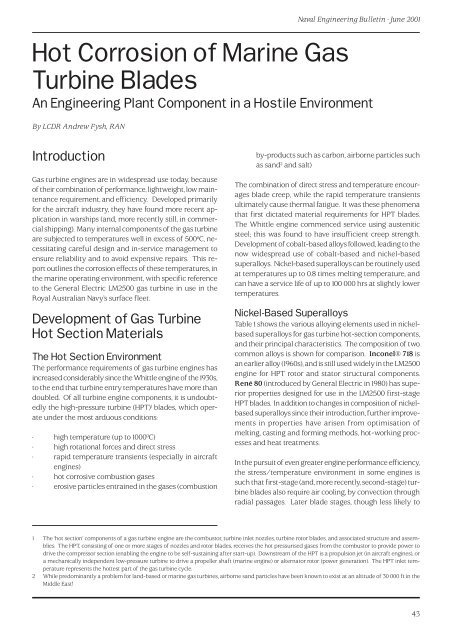Engineering - Royal Australian Navy
Engineering - Royal Australian Navy
Engineering - Royal Australian Navy
You also want an ePaper? Increase the reach of your titles
YUMPU automatically turns print PDFs into web optimized ePapers that Google loves.
Naval <strong>Engineering</strong> Bulletin • June 2001<br />
Hot Corrosion of Marine Gas<br />
Turbine Blades<br />
An <strong>Engineering</strong> Plant Component in a Hostile Environment<br />
By LCDR Andrew Fysh, RAN<br />
Introduction<br />
Gas turbine engines are in widespread use today, because<br />
of their combination of performance, lightweight, low maintenance<br />
requirement, and efficiency. Developed primarily<br />
for the aircraft industry, they have found more recent application<br />
in warships (and, more recently still, in commercial<br />
shipping). Many internal components of the gas turbine<br />
are subjected to temperatures well in excess of 500 0 C, necessitating<br />
careful design and in-service management to<br />
ensure reliability and to avoid expensive repairs. This report<br />
outlines the corrosion effects of these temperatures, in<br />
the marine operating environment, with specific reference<br />
to the General Electric LM2500 gas turbine in use in the<br />
<strong>Royal</strong> <strong>Australian</strong> <strong>Navy</strong>’s surface fleet.<br />
Development of Gas Turbine<br />
Hot Section Materials<br />
The Hot Section Environment<br />
The performance requirements of gas turbine engines has<br />
increased considerably since the Whittle engine of the 1930s,<br />
to the end that turbine entry temperatures have more than<br />
doubled. Of all turbine engine components, it is undoubtedly<br />
the high-pressure turbine (HPT) 1 blades, which operate<br />
under the most arduous conditions:<br />
• high temperature (up to 1000 0 C)<br />
• high rotational forces and direct stress<br />
• rapid temperature transients (especially in aircraft<br />
engines)<br />
• hot corrosive combustion gases<br />
• erosive particles entrained in the gases (combustion<br />
by-products such as carbon, airborne particles such<br />
as sand 2 and salt)<br />
The combination of direct stress and temperature encourages<br />
blade creep, while the rapid temperature transients<br />
ultimately cause thermal fatigue. It was these phenomena<br />
that first dictated material requirements for HPT blades.<br />
The Whittle engine commenced service using austenitic<br />
steel; this was found to have insufficient creep strength.<br />
Development of cobalt-based alloys followed, leading to the<br />
now widespread use of cobalt-based and nickel-based<br />
superalloys. Nickel-based superalloys can be routinely used<br />
at temperatures up to 0.8 times melting temperature, and<br />
can have a service life of up to 100 000 hrs at slightly lower<br />
temperatures.<br />
Nickel-Based Superalloys<br />
Table 1 shows the various alloying elements used in nickelbased<br />
superalloys for gas turbine hot-section components,<br />
and their principal characteristics. The composition of two<br />
common alloys is shown for comparison. Inconel® 718 is<br />
an earlier alloy (1960s), and is still used widely in the LM2500<br />
engine for HPT rotor and stator structural components.<br />
René 80 (introduced by General Electric in 1980) has superior<br />
properties designed for use in the LM2500 first-stage<br />
HPT blades. In addition to changes in composition of nickelbased<br />
superalloys since their introduction, further improvements<br />
in properties have arisen from optimisation of<br />
melting, casting and forming methods, hot-working processes<br />
and heat treatments.<br />
In the pursuit of even greater engine performance efficiency,<br />
the stress/temperature environment in some engines is<br />
such that first-stage (and, more recently, second-stage) turbine<br />
blades also require air cooling, by convection through<br />
radial passages. Later blade stages, though less likely to<br />
1 The ‘hot section’ components of a gas turbine engine are the combustor, turbine inlet nozzles, turbine rotor blades, and associated structure and assemblies.<br />
The HPT, consisting of one or more stages of nozzles and rotor blades, receives the hot pressurised gases from the combustor to provide power to<br />
drive the compressor section (enabling the engine to be self-sustaining after start-up). Downstream of the HPT is a propulsion jet (in aircraft engines), or<br />
a mechanically independent low-pressure turbine to drive a propeller shaft (marine engine) or alternator rotor (power generation). The HPT inlet temperature<br />
represents the hottest part of the gas turbine cycle.<br />
2 While predominantly a problem for land-based or marine gas turbines, airborne sand particles have been known to exist at an altitude of 30 000 ft in the<br />
Middle East!<br />
43
















